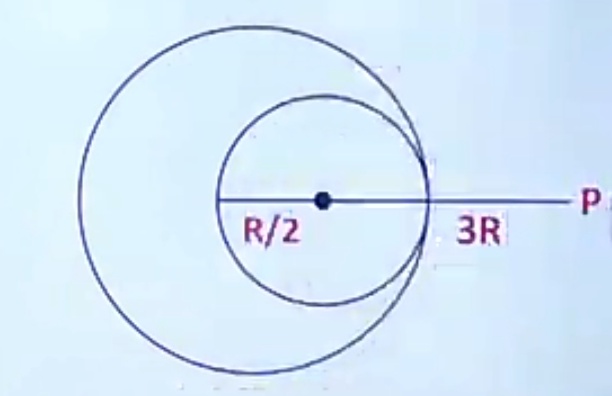Assuming a particle to have the form of a ball and to absorb all incient light, find the radius of a particle for which its gravitational attraction to the sun is counterbalanced by the forces that light exerts on it. The power of light raiated by the sun equals P=4.1026W, and the density of the particle is ρ=1.0g/cm3.
Let r=radius of the ball
R= distance between the ball & the sun (r<<R).
M= mass of the sun
γ= gravitational constant
Then γMR24π3r3ρ=P4πR2πr2.1c
(the factor 1c converts the enegry recived on the right into momentum recived. Then the rifht hand side is the momentum recived per unit time and must equal the negative of the impressed force for equilibrium).
Thus r=3P16πγMcρ=0.606μm.
Topper's Solved these Questions
- OSCILLATIONS AND WAVESBook:IE IRODOV, LA SENA & SS KROTOVChapter:OSCILLATIONS AND WAVESExercise:Elastic Waves
Explore 39 Videos
- OPTICSBook:IE IRODOV, LA SENA & SS KROTOVChapter:OPTICSExercise:Exercise
Explore 2 Videos
- PHYSICAL FUNDAMENTALS OF MECHANICSBook:IE IRODOV, LA SENA & SS KROTOVChapter:PHYSICAL FUNDAMENTALS OF MECHANICSExercise:Relativistic Mechanics
Explore 49 Videos
Similar Questions
A perfectly absorbing solid sphere with a known fixed density, hovers stationary above the sun. This is because the gravitational attraction of the sun is balanced by the pressure due to the sun’s light. Assume the sun is far enough away so that it closely approximates a point source of light. Find the radius of the sphere and prove that it is independent of the distance of the sphere from the Sun.
View SolutionEstimate the dimesions of a particle, if the pres-sure of the light from the sun on it compensates the gravita-tinal force. Assume the particle to be an absolute black body, its density to be 2.0×103 , and the solar con-stant to be 1.36 kW/m2.
View Solution
Knowledge Check
Assuming a particle to have the form of a sphere and to absorb all incident light, the radius (in mm) of a particle for which its gravitational attraction to the Sun is
Counterbalanced by the force that light exerts on it is------. The power of light radiated by the sun equals P=4×1026W and the density of the particle is r=1.0g/cm3. Use G=203×10−11Nm2/kg2, π=258 and mass of the sun =2×1030kgA0.8B0.6C0.1D0.4A perfectly absobing, black, solid sphere with constant density and radius R, hovers stationary above the sun. This is because the gravitational attraction of the sun is balanced by the pressure due to the sun's light. Assume the sun is far enough away that it closely approximates a point source of light. The distance from the centre of the sun at which the sphere hovers is :
Aproportional to RBproportional to 1/RCproportional to 1/R2Dindependent of RDust particles released by comets are continuously acted upon by sun's radiation pressure in radial outward direction. Assuming a dust particle with ρ=3.5×103kg/m3 and reflection coefficient 0. for what value of radius r does gravitational force on dust.
particle just balance the radiation force on it from sunlight ? (power radiated by sun =4×1026W , mass of sun =2×1030kg)A0.1μηB0.17μηC10μηD17μη
Two particles of mass 200 g each are placed at a separation of 10 cm. Assume that the only forces acting on them are due to their gravitational attraction. Find the acceleration of each when they are allowed to move.
View SolutionA solid sphere of uniform density and radius R applies a gravitational force of attraction equal to F1 on a particle placed at a distance 3R from the center of the sphere. The 1 sphere with the cavity now applies a gravitational force F2, on the same particle. Then ratio F1F2 is

View SolutionkAS particle of mass 100 g is kept on the surface of a uniform sphere of mass 10 kg and radius 10 cm. Find the work to bbe dne against the gravitational force between them to take the particle away from the sphere.
View SolutionA beam of white light is incident normally on a plane surface absorbing (70%) of the light and reflecting the rest. If the incident beam carries 10 W of power , find the force exerted by it on the surface .
View SolutionA beam of white light is incident normally on a plane surface absorbing 50% of the light and reflecting the rest. If the incident beam carries 10 W of power, find the force exerted by it on the surface.
View Solution